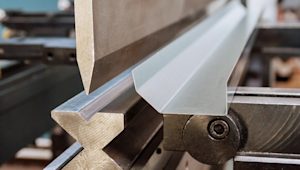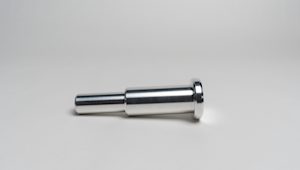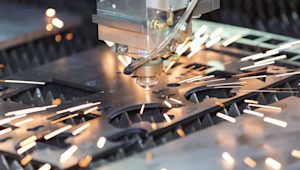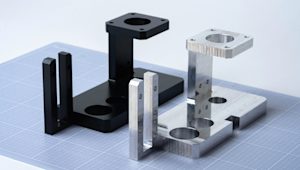What are the scales of production?
“Scales of production” refers to the volume or quantity in which a part is produced. Generally, there are three scales of production.
-
One-off production
-
Batch production
One-off production
One-off involves creating a single item. This could be a finished product, like a custom part, or a prototype used for design validation. Companies that manufacture one-off usually produce between one and 100 units per year, known as low-volume production. The Protolabs Network Quote Builder provides a cost-effective way to manufacture a single part, or many different customizations, whereas traditional manufacturers usually require placing higher-volume orders. What are the advantages of one-off production?
-
Customization. One-off production lets you easily tweak a design to your exact specifications, from size to features to colors. This allows for higher degrees of personalization you may not be able to normally achieve with larger production scales.
-
Testing and prototyping. Creating a single part allows you to easily test a design before moving into full production. In turn, this can help fully optimize a design, so you can avoid costly mistakes down the road.
-
Reduced inventory. A single part typically poses no storage or inventory-related challenges, unless the item is extremely large – like a custom car.
What are the disadvantages of one-off production?
-
Higher costs per part. Manufacturing single items doesn't usually let you benefit from economies of scale. They also may require specialized materials or incur labor costs that are avoidable with larger production runs.
-
Longer lead times. One-off production may result in longer lead times, as the part or product you are creating requires much more attention to detail than bulk manufacturing.
-
Scalability. Unless your one-off part is a prototype, it may be difficult to expand into larger scales of production should demand increase.

Batch production
Batch, or small batch production, refers to manufacturing the same type of parts or products in limited or set numbers. It correlations with medium-volume production of 100-10,000 units per year. Batch production can give you similar customization options as one-off production, while allowing you to optimize your production process for efficiency. Airplane parts are a good example of parts that are usually created with batch production.
What are the advantages of batch production?
-
More affordable than one-off production. Batch production runs can benefit from economies of scale, which can mean reduced per-unit costs. This means parts created with batch production are often cheaper than one-off production runs.
-
Easier adjustment to market demands. Should demand for your part or product increase or decrease, it is easier to adjust your manufacturing process to meet it. Larger scales of production, meanwhile, can lock you into a certain number of parts, while one-off parts can be time-consuming to create.
-
Increased repeatability. Because you are creating a certain number of the same parts, you can use jigs or CNC machines to quickly and efficiently create them. This isn’t always possible with other production scales, especially with one-off parts.
What are the disadvantages of batch production?
-
Increased setup costs. You may need different machines or tools, which can be quite costly, to create an efficient batch manufacturing setup.
-
Inventory storage. Batch production means you’ll need a place to store inventory, even if it is a small amount of parts.
-
Less customization. Batch production isn’t usually suitable for prototyping, as it limits the potential for per-part customization. Instead, you would have to retool for the next batch in order to add new or change existing features.
Higher-volume production
Higher-volume or mass production involves the large-scale manufacture of standardized parts or products. It correlates with high-volume production of 10,000 or more units per year. Higher-volume production usually involves production or assembly lines, which can be continuously active, 24 hours per day, seven days per week (this would be known as “continuous production”). This type of manufacturing is used to create a huge variety of parts intended for end-use from cars to smartphones – or anything else that is sold or used by the thousands (or even millions).
What are the advantages of higher-volume production?
-
Economies of scale. As the number of parts you manufacture increases, the price-per-unit decreases. This means mass-produced parts are often much cheaper than those produced in smaller production runs.
-
Automation. Mass production can often be automated, or used in production lines such as assembly or finish lines. This can greatly increase efficiency and decreasing costs that would otherwise be devoted to skilled labor.
-
Easy replacements. Standardized parts can be easily replaced or remanufactured, which can reduce downtime should a part break or wear down.
What are the disadvantages of mass production?
-
High startup costs. The equipment required for mass-producing parts can be prohibitively expensive – even more so than small or medium batch runs. This usually poses a challenge to anything but large organizations.
-
No customization. Mass-produced parts are standardized, which means there is essentially no room for customization or personalization.
-
Quality control. While QC is always an issue, regardless of the production scale, it can be very challenging to ensure it when producing parts on a mass scale, meaning you’ll have to devote special attention to preventing or detecting errors or defects as they occur.

How to choose a scale of production
To choose the scale of production that is best-suited for your part or product, you can ask yourself the following questions.
-
What is the size of the market or the demand for the part or product you want to create?
Often, the higher the demand or market size, the higher the scale of production you’ll need to create it. -
What are the costs required for materials, labor, and equipment at the various scales of production? How do they compare with your ideal cost per unit of the part you want to create?
Lower cost-per-unit is typically a result of a higher production scale. -
What degrees of customization or personalization will your parts need? Higher degrees of customization usually necessitate lower production scales.
-
How short (or long) do your lead times need to be?
Typically, the lower the production scale, the shorter the lead time. -
How stringent must your quality control measures be?
Often, the more stringent your QC must be, the more suited it is to lower production scales.
What manufacturing methods are best for the different scales of production?
Some manufacturing methods are better suited to different scales of production. Let’s take a look at three of Protolabs Network’s most popular manufacturing methods, as well as the production scales they can help you with.
-
CNC machining. A great choice for precise, detailed one-off parts or prototypes, as well as batch or higher-volume production, especially when higher degrees of flexibility and quality control are necessary.
-
3D printing. 3D printing is first and foremost a great method of prototyping. It can also be well-suited for small batch runs, as it requires no expensive tooling and offers good degrees of flexibility with relatively minimal setup. However, 3D printing is limited in its ability to effectively and efficiently mass produce large batches of parts, as it is often slower than other manufacturing methods. However, the technology is evolving very quickly and has a great deal of potential for such production scales in the future.
-
Injection molding. Injection molding is king when producing plastic parts. It can also be a good choice for medium-batch production, depending on what you are creating, as it is very cost-efficient. But, because it has high setup costs (it usually requires building custom tooling), it is most cost-efficient for large production runs of parts.
Order parts at different production scales
Which scale of production does your project require? For single parts, get an instant quote and lead times by uploading a CAD file to our Quote Builder. For higher volumes of components, find out how we help you to scale up to production quantities.
You can also read more about designing for product scalability and design for manufacturability (DFM).
Frequently asked questions
How does scale affect production costs?
Larger production scales often reduce per-unit costs due to economies of scale, while smaller scale may have higher per-unit costs.
What challenges are presented by large-scale production?
Increased complexity, the need for higher degrees of coordination, and potential loss of flexibility can pose challenges in managing large-scale production.
What are the benefits of small-scale production?
Customization and flexibility are advantages, although per-unit costs may be higher compared to larger production scales.
Does production scale affect product quality?
Quality control can often be more easily managed in smaller scale production. Larger production scales may require stricter protocols to maintain quality standards.



















